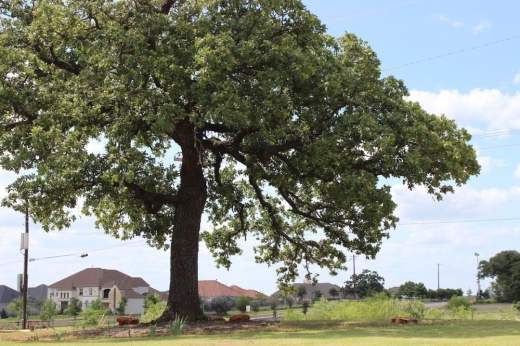A town strategic planning session in July 2021 led to more conversations and public feedback about how the land should be built out while preserving the area’s East Cross Timbers, which is a narrow strip of timbered country, various tree species, said Lexin Murphy, Flower Mound’s director of planning services.
The East Cross Timbers span three counties, and the conservation area spans 26,000 square miles in all.
“The Cross Timbers Conservation Development District is so unique, and it’s part of what makes Flower Mound so unique,” Flower Mound Mayor Derek France said. “To have a largely intact ecological area in the middle of one of the largest metros in the United States is special, and as a town, we want to make sure we honor this asset.”
The district is 9,544 acres with 3,681 acres accounting for the Army Corps of Engineers property, flood plains and streets, according to the town.
The developed portion of the district—about 59%—consists mostly of agricultural and rural uses, such as the Circle R Ranch, as well as housing developments. While 12% of the land is preserved from development, the remaining 29% of undeveloped land is zoned mostly for residential use, although some agriculture-type development is also allowed, according to the town.
The town hosted several community meetings in March where residents pushed to maintain a rural feel in the district. City staff will now work with the Town Council in June to finalize potential changes, which could include changes in zoning.
Community conversations
The balancing act between conservation and property owner rights made up a large portion of the community conversations surrounding the conservation development district.
Development uses in the conservation district include agricultural rural development, agricultural, agricultural conservation and cluster development.
The town held two public meetings in March to gauge community feedback on the Cross Timbers Conservation Development District. During those conversations, a portion of public speakers pushed to remove the cluster development option.
Cluster development zoning allows for developers to build lots with a minimum of half an acre, according to city documents, and residents argued that dense housing allowed with those smaller lot sizes could take away from the rural feel of the area.
Nearly 1,000 residents in a February 4 to March 11 survey said 1-acre lot sizes for the conservation district is ideal. About 85% of residents in the same survey said the town’s “beautiful rural atmosphere” is a top reason they moved to the area.
The council had a work session in April to go through the public feedback. During the work session, town staff recommended merging the cluster and conservation development standards together, Murphy said. The change would allow for more acreage per lot compared to a standard cluster development. The recommendation, though, is still evolving through council feedback.
Another council meeting will be held in June to discuss potential changes. Based on that meeting, staff will bring an item to the planning and zoning commission for approval, after which it would go before the council for approval.
The Cross Timbers Conservation Development District is a mostly rural part of Flower Mound.
“So [the district is] less focused on commercial uses there and more on how we can have environmentally sensitive development that really honors these ecological resources that are already in this area,” Murphy said.
There are some types of nonresidential uses that are more focused on environmentally sensitive developments, such as equestrian, and country commercial uses, she said.
Conservation efforts
The East Cross Timbers is an approximately 26,000-square-mile wooded area that runs through Denton, Tarrant and Johnson counties. It contains a number of tree and mammal species, but in Flower Mound the post oak and blackjack oak are key points of conservation.
Post oak and blackjack oak trees are two of the main tree populations that are protected in the district.
“There was an opportunity to ensure that we can preserve any of those cross timber-type trees and groves, and that sort of thing that still exists in that area,” Murphy said. “[It’s] also an opportunity to ensure that the town keeps that kind of unique country atmosphere and the natural environment that I think a lot of people feel are synonymous with Flower Mound.”
The conservation efforts are outlined in the town’s tree ordinance, said Matt Woods, Flower Mound’s director of environmental services. The focus is smart growth in terms of development and broader conservation.
“The tree ordinance was designed to protect certain species and size protection,” he said.
The ordinance encourages the protection of healthy trees and large native trees, according to the town. The trees provide energy savings by cooling the air around buildings.
Maintaining the trees is an important part of Flower Mound and its persona. People who move to Flower Mound say part of the reason they move here is for the trees, said Jimmy Hoefert, the town’s environmental review analyst.
“A tree is on our logo,” he said.
Many woodland areas in the region have been cleared for tame-grass pastures; croplands; horse and cattle ranches; and urban and rural developments, including portions of the cities of Denton, Dallas, Fort Worth and other expanding inter-city and rural communities, according to the Texas Parks & Wildlife Department’s website.
Urban growth and expansion will continue to impact wildlife habitat resources in the future. Wildlife management in the East Cross Timbers will require “innovative approaches to management of the habitat resources found there,” according to the Texas Parks & Wildlife Department.
Conservation efforts in Flower Mound allow the town to maintain the natural habitat for birds, mammals and insects while also maintaining air and water quality, Woods said.
“It’s a unique habitat the town felt was important,” he said.





